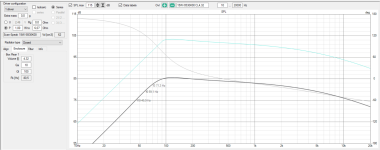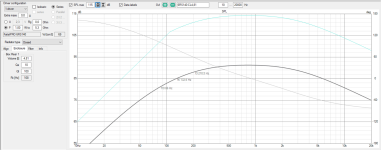I suggest getting efficient professional drivers instead of using multiple weak ones
Efficiency doesn't have much to do with the max SPL targeted. Pro drivers also suffer from limited Xmax and thermic compression. You might hope their high SPL performance would be better than that of multiple low efficiency drivers, but there's not a lot of proof. And pro drivers are often just another tradeoff regarding efficiency vs. distortions caused by design choices in the motor, cone and suspension. The motor in good low efficiency drivers like the ScanSpeaks certainly isn't worse than that of pro drivers.
Yeah we could imagine that some engineer would have thought at some point that a pro driver is likely to be used near maximum output for few hours at a time. Perhaps then designed the driver so that when the heat builds up with some typical signal and situation the sound doesn't go into poo but aligns to the specification instead. Perhaps the small signal TS parameters are published with the assumption of a heated up system so that the boxes get built so that when in real use the system Q stays and so on for the two hot hours. Perhaps the compression effects are long term from heating and not instantaneous, perhaps the accumulating heat provides this headroom for suspencion so that the attacks still come through. Maximal output with "dynamic" sound without audible effects of the abuse for example. Hard to know whether something like this is going on.
Perhaps some pro drivers are designed to be used in "too small" boxes for portability, consequently to withstand a lot of power to overcome the small box for some low frequency output, so some other set of compromises instead.
Perhaps drivers designed for hifi market it is more advantageous to assume they are listened with relatively low power and heat and the system TS specs are published so that optimal operation with boxes is achieved with relatively low temperature. This would mean that cranking up such system the heat builds up, parameters drift and sound goes poo. In this sense, for low heat listening the home hifi drivers would be more suitable for home hifi use, than pro drivers, if looking at the manufacturer specifications. Home hifi drivers would work within their published specification most of the time. Then, if one needs a loud system for home then just use many of these drivers so that the heat stays low for the occasional loud listening. Or one could use pro drivers but measure specs in cold operation temperature instead of reading the manufacturer specification to optimize build for the low heat home hifi situation.
Just speculation.
Perhaps some pro drivers are designed to be used in "too small" boxes for portability, consequently to withstand a lot of power to overcome the small box for some low frequency output, so some other set of compromises instead.
Perhaps drivers designed for hifi market it is more advantageous to assume they are listened with relatively low power and heat and the system TS specs are published so that optimal operation with boxes is achieved with relatively low temperature. This would mean that cranking up such system the heat builds up, parameters drift and sound goes poo. In this sense, for low heat listening the home hifi drivers would be more suitable for home hifi use, than pro drivers, if looking at the manufacturer specifications. Home hifi drivers would work within their published specification most of the time. Then, if one needs a loud system for home then just use many of these drivers so that the heat stays low for the occasional loud listening. Or one could use pro drivers but measure specs in cold operation temperature instead of reading the manufacturer specification to optimize build for the low heat home hifi situation.
Just speculation.
Last edited:
For reference here are two drivers, specs from VCAD database and in default closed box alignment what the system suggests. 15W(k00) and Faital Pro 6RS140 (I didn't have specs for early mentioned 6nd430)
They have quite similar maximum volume displacement so the low frequency output is similar and limited by the volume displacement before xmax. Sensitivity of the pro driver is higher on mid frequencies, also power handling is greater so can go louder at the mid frequencies.
Well, nothing to see here other than perhaps an idea that if a driver is optimized for some particular midrange bandwidth its probably more sensitive there than if the same (size) driver was optimized for low frequency output also, wider bandwidth. Pro systems and thus drivers marketed for them kind of assume that the small drivers are for limited bandwidth midrange use and separate big system reproduces the bass. In hifi driver realm there is a lot of small drivers on the market that are intended for both low and mid frequency use which can give impression they are not as sensitive simply because they are optimized for different application.
I think this is the confusion and suggestion here. There is no point to use a driver in a mid range application that was designed for low frequencies as well, because its not as sensitive on its bandwidth in the application needing multiple which means more cost, potential wasted and money wasted. More specialized driver could provide required sensitivity for the bandwidth with lower cost.


They have quite similar maximum volume displacement so the low frequency output is similar and limited by the volume displacement before xmax. Sensitivity of the pro driver is higher on mid frequencies, also power handling is greater so can go louder at the mid frequencies.
Well, nothing to see here other than perhaps an idea that if a driver is optimized for some particular midrange bandwidth its probably more sensitive there than if the same (size) driver was optimized for low frequency output also, wider bandwidth. Pro systems and thus drivers marketed for them kind of assume that the small drivers are for limited bandwidth midrange use and separate big system reproduces the bass. In hifi driver realm there is a lot of small drivers on the market that are intended for both low and mid frequency use which can give impression they are not as sensitive simply because they are optimized for different application.
I think this is the confusion and suggestion here. There is no point to use a driver in a mid range application that was designed for low frequencies as well, because its not as sensitive on its bandwidth in the application needing multiple which means more cost, potential wasted and money wasted. More specialized driver could provide required sensitivity for the bandwidth with lower cost.


Last edited: